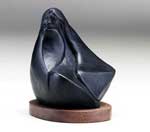VAM galleries including this work:
The Owensboro Museum of Fine Art | Art Through Time || VAM Home
Allan Houser (Warm Springs Chiricahua Apache, 1914-1994)
YOUNG WOMAN II, 1989
Bronze; 6-1/4" X 5" X 5" deep
A Gift of William R. Young III in Memory of Marilyn Field Young
Collection of Owensboro Museum of Fine Art
In the last two decades of his life, Allan Houser created more than 1,000 sculptures in wood, stone, and bronze. Like this work, many were portraits of Native Americans and Native American life. Houser’s blending of Native American imagery and modernist style gained him international recognition as an important artist of the 20th century.
About the Artist
Allan Houser was born Allan Capron Haozous (pronounced Ha-oo-zohs, meaning “the sound of pulling roots”) on June 30, 1914 in Apache, Oklahoma, to Sam and Blossom Haozous, who were members of the Warm Springs Chiricahua Apache tribe. This great-nephew of Geronimo was one of the first Chiricahua Apaches born into freedom after forced removal of the tribe from its New Mexico lands and decades of imprisonment by the U.S. government in Florida and Oklahoma.
At an early age, Allan began making drawings and carvings. He trained as a painter at the Santa Fe Indian School in New Mexico and the Fort Sill Indian School in Lawton, Oklahoma, and studied with painter Dorothy Dunn (1903-1991) and muralist Olle Nordmark (b. 1890). While in art school, he changed his surname to Houser. His work was exhibited at the 1936 World’s Fair in New York, and in 1939 he was commissioned to paint a mural for the Department of Interior building in Washington, DC.
“Human dignity is very important to me.... In my work this is what I strive for—this dignity, this goodness that is in man.”
In 1941, Houser and his wife and sons moved to Los Angeles, where he saw museum exhibitions of European modernists such as Brancusi, Arp, Lipschitz, and Henry Moore—works that would have a lasting influence on Houser in the coming decades.
His first major marble carving, Comrade in Mourning, was a memorial for the Haskell Institute in Lawrence, Kansas, honoring the Native American students from Haskell who died in World War II. In the 1960s, as he taught and created sculpture at the Institute of American Indian Arts in Santa Fe, Houser began integrating modernist aesthetics into his work. The fluid lines and subtle detailing of his stone, steel, and bronze sculptures pushed his work outside the genre of Native American or Western art and into the broader context of modernist and contemporary art. “Human dignity is very important to me,” Houser said. “I feel that way toward all people, not just Indians. In my work this is what I strive for—this dignity, this goodness that is in man.” Houser continued working until his death in 1994.
Houser won a variety of awards throughout his career, including the 1st Annual Visionary Award from the Institute of American Indian Arts Foundation, Santa Fe, NM, 1996, and a Guggenheim Fellowship in painting and sculpture in 1948. In 1992, President George Bush awarded Houser the National Medal for the Arts.
Work by Houser is held in many collections in Europe, along with such U.S. collections as the Metropolitan Museum of Art and the Museum of Modern Art, both in New York, and the National Museum of American Art and National Portrait Gallery in Washington, DC. His was among the work chosen for the inaugural exhibits at the Smithsonian’s National Museum of the American Indian in 2005.
Classroom Ideas
Discussion: How does Houser use curved lines and smooth texture to create movement in his work? Compare this work to the sculpture by Henry Moore in the Virtual Art Museum. Discuss the quote by Houser. Does his work successfully convey the dignity he sees in humanity? How?
Activity: Sketch a portrait or create a portrait in clay in Houser’s style. What are the challenges?
Links
Find out more about Houser, his works, and his life at the Allan Houser Inc. web site.
[www.allanhouser.com]
View another Houser work and read more about his life at the Eiteljorg Museum.
[www.tfaoi.com/newsmu/nmus76h.htm]
Learn about Native American cultures and art at the National Museum of the American Indian, part of the Smithsonian Institution.
[www.nmai.si.edu]

